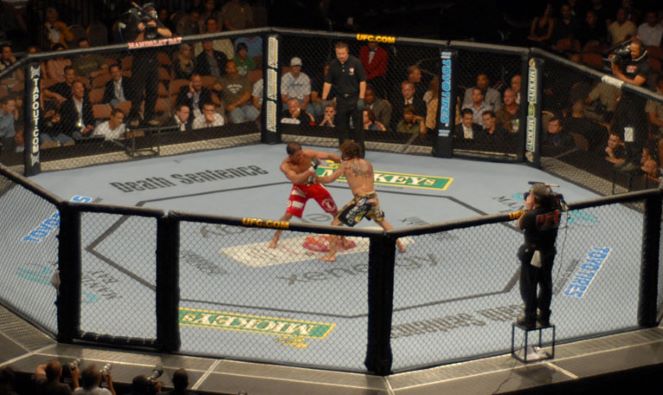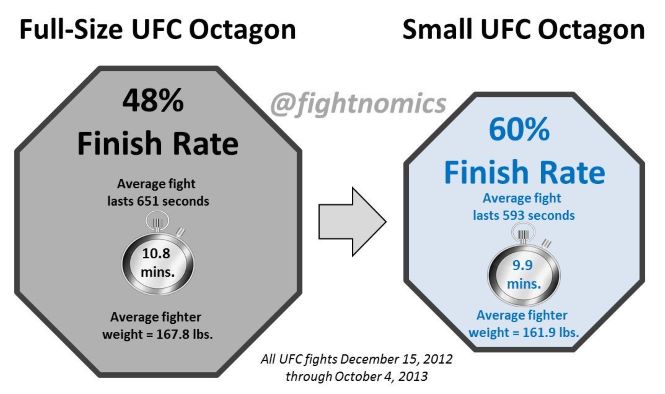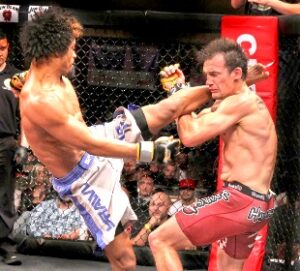
Do you have a question about the UFC octagon?
In this article, we’ll look at the UFC octagon sizes, what the UFC octagon floor is made of, why the UFC uses an octagon, the history of the octagon, whether other MMA promotions use an octagon, and how the size of the octagon influences fight outcomes.
Contents
What’s the UFC Octagon Size?
There are two UFC octagon sizes. The original and larger UFC octagon is 30 feet across (9.1m), and 5 feet 9 inches high (1.8m), with the inside fight space measuring 746 square feet.
The smaller UFC octagon is 25 feet (7.6m) in diameter, is the same height as the original, and has a total space of 518 square feet.
Here’s a table showing the similarities and differences between the two UFC octagons:
| Details | Original Full-Size UFC Octagon | Small-Size UFC Octagon |
| Inside Diameter | 30 feet across (9.1m) | 25 feet across (7.6m) |
| Outside Diameter | 8 feet across (2.4m) | 8 feet across (2.4m) |
| Total Diameter | 38 feet across (11.5m) | 33 feet across (10m) |
| Inside Area | 746 square feet | 518 square feet |
| Height From Canvas to Top of Fence | 5 feet, 9 inches (1.8m) | 5 feet, 9 inches (1.8m) |
| Height From Ground to Canvas | 4 feet high (1.2m) | 4 feet high (1.2m) |
| Entrance Gates Diameter | 3 feet wide (0.9m) | 3 feet wide (0.9m) |
| Entrance Gates Height | 5 feet high (1.5m) | 5 feet high (1.5m) |
The smaller UFC octagon has the same height and is only smaller in diameter and square feet.
The outside diameter is used as a catwalk for the UFC ring girls, and there are stairs at either gate. As the outside diameter is 8 feet (2.4m), the catwalk is 1.2m wide all the way around.
Overall, the standard full-size UFC octagon is 44% larger and 20% wider than the smaller-sized octagon.
What Is the UFC Octagon Floor Made Of?
The UFC octagon floor is made from a layer of OSB boards (Oriented strand board), covered with roughly 2” (5 cm) of closed-cell foam, either EVA or polyethylene, which is lastly covered with canvas. The canvas is heavy cotton with a weight of 530 g / m2, which ensures durability and heavy-duty use.
These three layers are on top of a metal frame foundation. The canvas is also hand-painted and textured and used only once for each event. This is because it’ll be covered with blood and UFC sponsors change for each event.
The fence is metal chain-linked, coated with black vinyl. There is foam padding on top of the fence and between each of the eight fences which runs from the top of the cage to the canvas.
While the UFC octagon floor is made of materials supporting MMA and preventing unnecessary injuries, between the fence and the canvas there’s a small gap which can be dangerous as fighters have hurt themselves by unintentionally stepping in the gap.
Why Does the UFC Use an Octagon?
The UFC uses an octagon for a few reasons, and these are:
Safety
The UFC octagon has an eight-sided fence preventing fighters from falling out, as in a traditional ring most often used in boxing, kickboxing, and muay thai, fighters can fall out between the ropes.
Ropes also tangle fighters, especially during clinch exchanges, and there have been many examples of MMA athletes getting tangled and falling out of rings in other promotions.
Interference
In MMA promotions that have used ropes such as Pride FC, officials on the outside have had to touch fighters in order to keep the action on the inside. Per the Unified Rules of MMA, touching fighters during a fight is considered interference which is an illegal foul, as only the referee has permission to do so when stopping a fight.
Marketing
When the UFC started in 1993, it used an octagon to differentiate itself and MMA from boxing and wrestling, which used square and circular fighting spaces. The idea of a cage was taken from the film, Conan The Barbarian, as at the start of the film fighting takes place in an octagon-shaped cage.
Performance & Fairness
The use of an eight-sided fence removes the possibility of a fighter getting trapped in a corner by boxers or kickboxers who are trained in cutting off the ring and is also more appropriate for grappling. The UFC wanted an arena that leveled the playing field and represented no preference for any one type of martial art.
The fence is also there to be used by fighters, both offensively and defensively, so it adds more to the fight.
Offensively, a fighter can push off the fence to generate power or height and incorporate creative surprise attacks, such as a superman punch. Defensively, a fighter can push off the fence when mounted as a way to escape or change position, commonly known as a wall walk.
UFC Octagon History
The men responsible for the UFC octagon are Rorion Gracie, Art Davie, and Eric Cusson.
When Art Davie drew up the business plan for the start of the UFC, Rorion showed him vale tudo footage which saw fighters escaping a roped ring when grappling, as a way to re-enter on the feet in the center. The footage also showed fighters hurting themselves when falling out.
Along with these ideas, they also wanted to differentiate themselves from wrestling and boxing. After discussing many bizarre ideas, Eric Cusson, a video and film art director, designed an eight-sided arena with a chain-link fence; which became the UFC’s trademarked octagon still used today.
As previously mentioned, the idea of a cage was taken from the film, Conan The Barbarian, as at the start of the film fighting takes place in an octagon-shaped cage.
The UFC used the standard octagon until they merged with WEC in 2010, bringing over a lot of their fighters and the idea of a smaller UFC octagon. This is because WEC used a smaller MMA cage measuring 25 feet in diameter, and fans loved the high-action fights the WEC promoted.
Is the UFC Octagon Trademarked?
When the UFC was formed, the original shareholders partnered with SEG, to become 50/50 equals. After designing the UFC octagon, SEG had the term trademarked in 1993, which meant other promotions couldn’t use the name, ‘The Octagon’, or the same type of MMA cage (eight-sided fence).
However, 8 years later when the UFC was purchased by Zuffa in 2001, they gave permission for other promotions to use the octagon shape, but they kept exclusive rights for the name, ‘The Octagon’.
They allowed other promotions to use the octagon shape so the sport could unify under regulation and win official sanctioning. It’s hardly a unified sport if they’re the only promotion using a specific style of MMA ring, while every other promotion is using something else.
MMA Ring: Do All MMA Promotions Use the Same Size Cage?
The UFC itself uses two different-sized octagons, and MMA promotions use different-sized cages too. As well as using different sizes, they also use different shapes.
Here are a few examples:
- As the octagon shape was trademarked from 1993 to 2001, all other MMA promotions were using differently shaped fighting arenas. The best example is Pride FC, which operated between 1997 and 2007 and used a boxing-style five-roped ring, which has a total fight space of 655 square feet.
- Strikeforce refused to use an octagon and wound up using a hexagonal cage (6 sides).
- WEC formerly used a pentagon-shaped cage (5 sides) before changing to the smaller octagon with a 25 feet diameter.
- Bellator uses a circular cage measuring 36 feet (11m) in diameter, with a total fight space of 1018 square feet. This means the total fight space (inside) is 36% bigger than the UFC’s larger octagon of 746 square feet, and also 20% wider.
- One FC also uses a circular cage and has also used a five-roped ring for some of their MMA bouts, such as at their ONE: Heroes of Honor event. However, the ring is mostly used for their muay thai and kickboxing bouts.
- AMC Fight Nights, formerly known as Fight Nights Global (FNG) before 2021, was founded in 2010 and used a ring with MMA and kickboxing rules – before switching to an octagon in 2013.
How Do They Choose Which UFC Octagon Size To Use?
As already mentioned, the UFC octagon comes in two different sizes. The UFC can pick which cage they want for any event, and they don’t proactively tell fighters which cage is used for an event.
It’s up to a fighter to find out the octagon size when signing for a fight. This is important because the size of the octagon can change the dynamics of a fight, and affect strategy and style.
As a general rule, smaller arenas with less capacity tend to use the smaller octagon, while PPV events and larger arenas with larger capacities tend to use the bigger octagon. Some venues can’t fit the larger UFC octagon, such as the former venue, Palms Casino Resort, last used in 2018.
Dana White has maintained he prefers the bigger octagon because it looks better on broadcast, which is why it’s considered the standard.
Their own live events center, the UFC Apex in Las Vegas, Nevada, has used the smaller (25 feet) octagon 100% of the time since UFC on ESPN 9 on May 30, 2020.
This was the first event back at the UFC Apex since 5 UFC events were canceled due to covid. They used the smaller octagon because it creates more action, which is what they needed while fans were not in the arenas and the UFC was one of the first sports broadcasting live events during the covid pandemic.
How Does UFC Octagon Size Influence UFC Outcomes?
While a minority of people think UFC octagon size has no influence on the outcome of a fight, the majority of fighters and spectators believe it does.
This is supported by the alarming statistic showing the bigger octagon has a 48% finish rate, while the smaller-sized octagon has a 60% finish rate and 20% more strikes thrown.

While this statistic may be considered outdated, 2020 statistics show a finish rate of 56.3% in the smaller octagon, which was used in 208 out of 456 fights.
On the other hand, in the larger octagon, the finish rate for 107 fights before the pandemic was 40.1% and for the other 141 fights during the pandemic, it was 47%.
The UFC knows this, which is why the smaller octagon is used for Dana White’s Contender Series and The Ultimate Fighter – two shows that promote action and finishes as a way to earn a UFC contract.
Fighters can win on DWCS and not get offered a contract if the UFC feel they were not entertaining or attempting a finish. These two factors combined are the reason why 62% of roughly 200 fights on the contender series have ended via finish (submission or knockout).
The reason the smaller octagon results in more finishes is there’s less space for circling and evading engagement, which means a fighter either engages or uses a lot more energy than usual to evade.
This is especially true for heavyweights as they take up a lot of space and use less movement than lighter fighters, meaning they’re likely to stand and bang in the middle as there’s nowhere else to go, and evading may be wasted movement.
Also, a smaller cage means takedowns are harder as it’s easier to get to the fence where it can be used to increase takedown defense, again making striking more common.
Lastly, having less room to move means less time to react and think, this then reduces strategy and makes fighters stand and bang as it’s the most essential style in a smaller octagon where offense is the best form of defense.
To Summarize
The UFC has two different octagon sizes. The larger has a diameter of 30 feet and a total fight space of 746 square feet, while the smaller has a diameter of 25 feet and a total fight space of 518 square feet. Both are made from OSB boards, cell-closed foam, and an upper layer of canvas.
The standard full-size UFC octagon is 44% larger and 20% wider than the smaller-sized octagon and the octagon used makes a difference in how fights play out. Many MMA promotions have used different-sized and shaped fight arenas.
The UFC octagon was created by the early founders, Rorion Gracie, Art Davie, and Eric Cusson, and the shape of the octagon was trademarked until 2001, while the name is still trademarked to this day.
The UFC octagon was designed this way for reasons including, marketing, safety, performance benefits, and the removal of interference.




